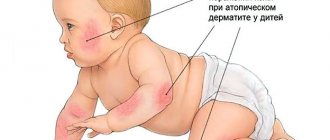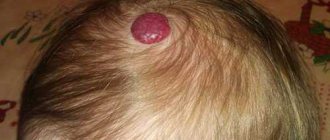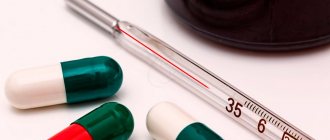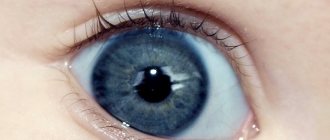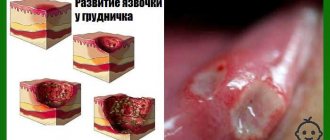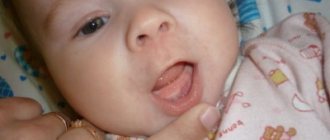Causes of rashes in children
The rash can have different origins. Most rashes in newborns are accompanied by a mandatory diet for the nursing mother. If this does not help, the child may be switched to artificial feeding with a mixture containing split cow's protein. In reality, allergic reactions in infants are rare. They are the ones who require the mother to diet or switch to a hypoallergenic milk formula.
The most common rash is erythema toxicum neonatorum. It may appear immediately after birth or on the second day. Neonatologists explain it as a reaction of the skin to the colonization of the intestines by beneficial bacteria. This rash does not require any special care or treatment, because it goes away on its own after a few days. Rarely rashes persist for up to 3 weeks.
Immunological rash
This type of rash is an allergic rash. Food allergies occur on the cheeks, less often on the body. A child can get an allergen through food while being both bottle-fed and breastfed. The latter means that the nursing woman consumed one of the types of allergens, to which the child’s body reacted. With artificial feeding, this indicates an incorrect selection of the formula and intolerance to some of its components. An allergic rash is most likely to occur when starting complementary feeding. To avoid serious consequences and know exactly which product causes an allergy, it is worth keeping a food diary. In it, the mother notes the introduction of new products and monitors the child’s reaction.
An allergy can manifest itself as a rash all over the body. Small red rashes appear in places where the child's skin comes into contact with allergens: pet hair, dust, and cosmetics. To avoid such a reaction, it is necessary to wash children's clothes only with baby soap and powder, and for the child use only special children's cosmetics that undergo strict quality control. But even this cannot protect against the occurrence of allergies.
IMPORTANT TO KNOW: Toning face masks at home: the best remedies
Dr. Komarovsky tells how to find the cause of allergies in the video below.
Symptoms and types of rashes
In order to figure out why a rash appeared on the head or body of a baby, you should remember all the events that preceded it, which may include:
- using a new detergent;
- buying new synthetic clothing;
- walking with a child in the hot season using a synthetic carrier;
- the mother of a breastfeeding child happily ate three oranges;
- Grandmother made delicious tea with condensed milk for the baby.
These are all common causes of rashes in children. In addition, if the rash has clear boundaries, each pimple contains a white head that becomes larger every day and then dries, it is most likely a bacterial infection.
Important! Pediatricians distinguish a bacterial infection from an allergic reaction by the appearance of the rash. As a rule, the presence of a white head on pimples indicates the presence of pus under the skin, which most often occurs as a result of the development of a staphylococcal infection.
A rash behind the ears in a child, spreading over the scalp, which is accompanied by severe peeling, may be seborrheic dermatitis. This condition is similar to dandruff in adults. By analyzing the fallen off crusts, the doctor will make an accurate diagnosis and prescribe treatment.
Causes of rashes in an infant (photo and description)
During infancy, from 1 month to 1 year, the skin of infants is susceptible to many pathologies.
READ ALSO: How to remove dark spots under armpits at home
This is caused by the following reasons:
- allergies;
- violation of hygiene rules;
- influence of maternal hormones;
- infections.
Hormonal rash – neonatal pustulosis
A small, red rash may appear in newborns in the first days and weeks after birth. This is the so-called hormonal rash.
The child’s hormonal system is rebuilt, begins to function independently and rejects the mother’s hormones.
Remnants of maternal hormones are released through the skin in the form of neonatal pustules. They look like papules with a white tip.
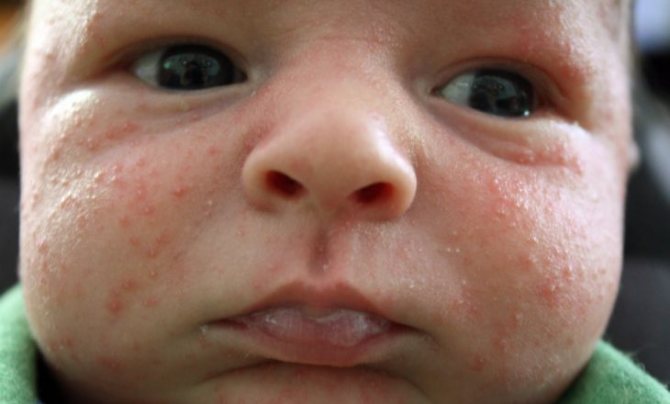
Usually located on the upper half of the body:
- head;
- forehead;
- cheeks;
- neck;
- back.
If proper skin care is not taken care of, a child may develop a fungal infection.
Separately, a rash is distinguished on the face and on the head (cephalic) in infants. They will be caused by the still imperfect functioning of the sebaceous glands or follicles and the simultaneous rapid proliferation of lipophilic yeast-like fungi such as Malassezia on the child’s face. Sometimes they are detected by light palpation.
The concern is that you may miss the signs and rashes caused by meningitis.
Signs of allergies
The appearance of a red rash on the cheeks of a baby primarily indicates the presence of an irritant.
- food products, drinks, mixtures;
- household items, clothing, toys;
- baby care products;
- environment, heat, cold, tobacco smoke.
After feeding, the mother will always notice the baby’s painfully pink cheeks and can guess what foods this happened after: those that she consumed herself or gave to the baby in complementary foods.
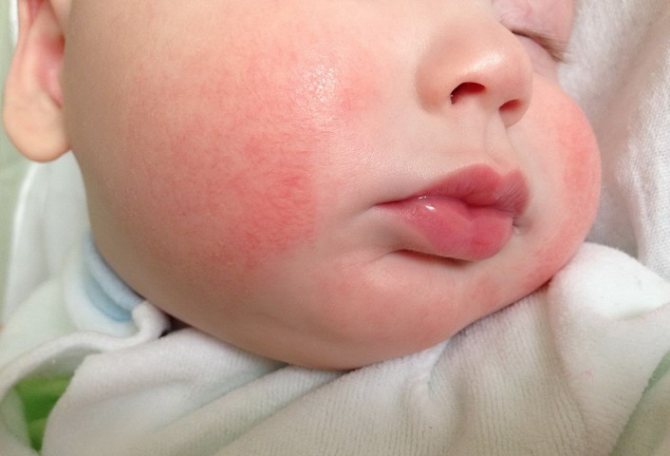
If a small red rash in a newborn does not disappear, merges, gets wet, crusts and peeling appear - you need to look for and identify the allergen.
Until the allergen is identified, the nurse herself must adjust her diet.
Avoid obviously allergenic foods:
- chocolate;
- citrus;
- honey;
- canned food;
- smoked meats
If the red rash and peeling on the face and body of the baby do not go away, you need to change the mixtures and carefully study their composition.
Additions to feedings should be done carefully, step by step. Start juices with drops, gradually increasing each day.
It is necessary to review the composition of creams, ointments, sprays, and powders that are used to treat the skin of babies.
Understand the toys, find out what material they are made of, who the manufacturer is.
Buy from natural fabrics:
- bed sheets;
- towels;
- blanket;
- diapers;
- baby vests;
- sliders;
- booties.
We need to find out if there are any smokers nearby. Maintain a constant indoor temperature.
Diaper dermatitis
Very often, children suffer from diaper dermatitis. It usually occurs on the body in places of contact with wet diapers, diapers, and diapers.
If you do nothing, the process progresses. Redness gives way to irritation, bright red diaper rash appears, and painful cracks form on it. Ulcers appear in their weeping gaps.
READ ALSO: Black dot on the lip: reasons for its appearance and how to remove it, reviews
The result depends only on proper care of the child. It is within the power of any mother to prevent such irritations.
If such a disaster has happened, it is necessary to more strictly control the hygienic care of the baby’s skin - wash it after each diaper change, bathe the child in string or chamomile, use baby creams and powders with zinc oxide.
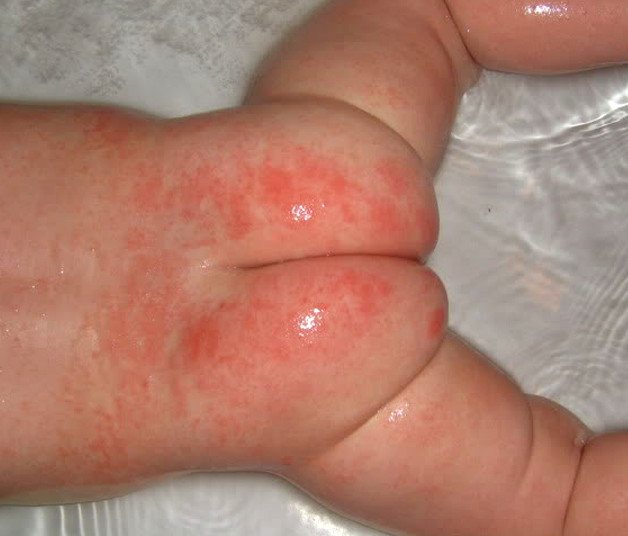
Atopic dermatitis
Atopic dermatitis develops in children with a hereditary predisposition.
It will be provoked by food products entering the child’s body and the mother’s body during pregnancy and breastfeeding.
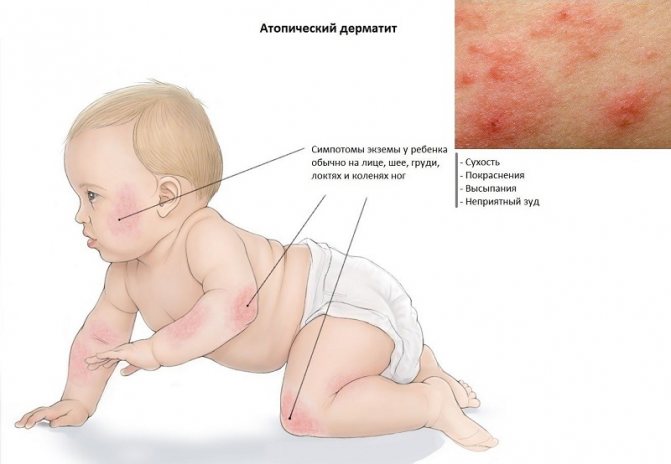
Scientists have found that the main allergen is whole milk protein. In second place are the proteins of soybeans, eggs, cereals, and fish.
The leading role in the development of dermatitis is given to the state of the digestive organs of the baby, the selection of food products of the mother during feeding and during pregnancy.
The child should not be overfed. Pasty children are more likely to suffer from atopic dermatitis.
The disease is dangerous because, starting with redness, peeling and itching of the cheeks and buttocks, the process expands and spreads, capturing the deeper parts of the skin on the body.
The resulting blisters become ulcers, the itching intensifies, greatly disturbing the baby.
Timely identification and elimination of the allergen will help to get rid of the disease faster.
Video from Dr. Komarovsky about atopic dermatitis:
Infectious rashes
Infectious rashes are caused by viruses, bacteria and fungi.
Fungal rashes are easily distinguished by the clear boundaries of clusters of small rashes. They quickly dry out, become covered with a white or yellowish coating, which is very flaky.
Among bacteria, a rash on a child’s body is most often caused by staphylococci and streptococci.
Infection with staphylococci manifests itself as pustular diseases.
Streptococcal infection is recognized by the appearance of a small red rash or blisters on the legs, arms, and face of a newborn. Blisters filled with exudate burst and the wounds dry out into crusts.
Viruses cause severe infectious diseases:
- measles;
- scarlet fever;
- chicken pox;
- rubella;
- Infectious mononucleosis.
The main signs of these diseases will be:
- heat;
- cough;
- a sore throat;
- nausea, vomiting;
- headache;
- abdominal pain;
- enlarged lymph nodes.
The rash will be a characteristic sign for each of them and distinguish them from each other.
Usually, rashes start from the scalp in the scalp, behind the ears, then appear on the face, cheeks, neck, and then go down to the body. They are found on the stomach, back, and buttocks. Then they cover the limbs up to the feet.
To make it easier to identify which infectious disease, here is a rash recognition table:
READ ALSO: How to quickly cure a boil at home on the butt, leg, face, eye, groin, under the armpit
| Disease | Type of rash | Color | Place and time of appearance |
| Infectious mononucleosis | Various in shape and size | Red | On the 5th – 6th day. On the face, less pronounced on the body. |
| Measles | Large spots, papules | Bright red | For 3 – 5 days. Appears behind the ears, along the hair, down to the feet. Step by step: face – torso – limbs. |
| Rubella | Small spots | Pale pink | Right from day 1. On the face, all over the body. |
| Scarlet fever | Small dots | Bright red on congested skin. Pale nasolabial triangle. | For 1 – 2 days. All over the body, worse in the folds. |
| Chicken pox | Spots, papules, blisters with liquid. Crusts. They develop gradually. Coexist at the same time. | Red | On the 2nd day. On the head, face, torso, mucous membranes. |
What to do if a rash appears
Sensible parents, at the first appearance of a rash on the face and head of a newborn, will consult a doctor. If they are sure that the rash appeared after sleep, when the mother was afraid to open the window and ventilate the room in the evening, they can do without medical help. It will be possible to bring the skin back to normal using water procedures and adjusting the microclimate of the room.
Prohibited actions when caring for an infant
If a mother decides to independently treat her baby, she should not forget that there are actions that should not be performed:
- squeeze out pimples;
- try to remove flaky skin using special hard washcloths;
- without doctor's recommendations, experiment with hormonal ointments and antibiotic-based products.
Attention! Touching a baby's damaged skin with dirty hands can lead to secondary infection.
How to help a baby
When a child's skin itches and peels, special attention should be paid to controlling the microclimate in the room.
Microclimate parameters
| Options | Minimum allowed value | Maximum allowed value |
| Air temperature | 16˚C | 22˚C |
| Air humidity | 55% | 70% |
Along with tidying up the air in the children's room, you need to pay attention to food. Children under three years of age should not be given the following:
- chocolate and other sweets;
- juice;
- citrus;
- nuts;
- honey;
- seafood rich in protein (shrimp, crayfish tails);
- spicy and canned foods.
Pimples on the face and body of a newborn
articles:
In the first days after birth, the newborn's skin may become covered with small pimples. They can be red, white, and can be localized in one area or evenly scattered throughout the body or face. A pediatrician will help you find out their origin and determine further actions. After all, some rashes require treatment, while others go away on their own.
Causes of the rash
The skin of an infant is an incredibly sensitive and delicate organ that reacts to almost any disturbance. Therefore, if a newborn has pimples, you first need to find out what factors provoked this condition.
Causes of rash in infants: • Allergy to food consumed by the child or mother (during lactation). • Allergic reaction to medications. • Skin diseases. • Heat rash. • Nettle fever. • Acne in newborns. • Infectious diseases.
Each variety will be discussed in more detail below.
Allergic reaction
Pimples on a newborn's cheeks and chin occur as a result of an allergic reaction to foods. The scaly, pink or red rash resembles a nettle burn in appearance. The rash can be located on the limbs, abdomen, and back.
With severe intoxication and regular contact with the allergen, acne takes the form of a scab and begins to get wet. If a baby drinks only mother's milk, then the mother's diet can trigger an allergy. In this case, it is necessary to identify the allergen and exclude it from the menu.
The most allergenic foods: red fish, whole milk, veal meat, citrus fruits, nuts, tomatoes. Proteins contained in infant formula also provoke an allergic reaction. A skin reaction may occur as a result of early or illiterate complementary feeding.
For this reason, before introducing new foods into your diet, you should consult your pediatrician. The likelihood of a rash increases after taking antibiotics, hormonal drugs and other medications.
An allergic reaction can occur due to taking multivitamin complexes, fluoride, iron and many medications based on herbal components. Therefore, while taking medications you need to be attentive to your health. If you notice that after taking the medication a side effect occurs in the form of a skin rash, you should stop taking it and consult a doctor.
Dermatitis
Pimples on a newborn's body occur due to contact dermatitis. Inflammation is provoked by washing powders or rinse aids with a large number of fragrances. In addition, allergies can be caused by the fabrics from which children's clothing is made. The most allergenic materials include wool and synthetic materials. Pimples in a newborn's groin are caused by diaper dermatitis.
This type of rash occurs due to prolonged contact of a baby's delicate skin with a wet diaper or diaper. In this case, acne is not an allergic reaction, and therefore there is no need to take antihistamines. Pimples on the bottom of a newborn can be achieved by following the basic rules of child care: keeping the skin clean and dry, changing diapers in a timely manner.
To heal damage, the following ointments are used: Bepanten, D-panthenol, Drapolene, Boro-plus, etc. If left untreated, diaper dermatitis is complicated by a bacterial infection. In this case, you cannot do without the help of a doctor. Antibiotics (Baneocin) and antifungal agents are used for treatment. A small blistering rash occurs against the background of atopic dermatitis.
This is an ailment of allergic origin, which most often occurs as a result of improper nutrition of a nursing mother. In addition, a rash can occur due to improperly introduced complementary foods, disruption of the intestinal bacterial flora, violation of hygiene rules, and the use of cosmetics with an irritating effect.
Hereditary predisposition is also a factor in the development of atopic dermatitis. It all starts with the baby developing a slight swelling on the forehead and cheeks. The skin on the limbs and buttocks turns red and peels. After a certain time, blisters appear on the inflamed area and itching occurs. In addition, the likelihood of enlarged palatine tonsils increases.
If such symptoms occur in a baby, immediately go to the pediatrician. In this case, it is necessary to identify the allergen as quickly as possible and avoid it in every possible way. Symptomatic therapy is carried out using anti-allergy drugs. As part of complex treatment, ointments, herbal infusions, biological products, and fermented milk products with beneficial bacteria are used.
Children who eat formula are prescribed hypoallergenic soy-based food. During lactation, honey, condensed milk, nuts, citrus fruits, etc. should be excluded from the diet.
Prickly heat
Small pink pimples often appear in infants, especially up to 12 months after birth. It appears to be a pink rash that bulges slightly when pressed. The inflammatory reaction is localized on the neck or chest, due to prolonged sweating in the heat. Most often, acne appears due to overheating and insufficient care of the baby.
Miliaria is not a contagious disease; moreover, this condition does not cause much discomfort in a newborn. When the body temperature returns to normal and the parents provide proper care for the baby’s skin, the heat rash goes away on its own. To speed up the process, treat the damaged areas with powder after hygiene procedures and drying of the skin.
Nettle fever
Red pimples in children that resemble a nettle burn occur for various reasons. They can be provoked by cold, heat, sun, or strong excitement. In addition, a rash very similar to hives can be caused by tight elastic bands or straps on clothes, car seats, backpacks, etc.
If the rash does not go away for a long time, you should consult a doctor. To eliminate the symptoms of urticaria, antihistamines are used: Suprastin, Zyrtec, Fenistil, etc. To eliminate severe itching in the baby, use an ointment with menthol oil and anesthesin.
In severe cases, hormonal ointments are used.
Acne in newborns
Red pimples with a white head appear in infants due to an increase in the amount of maternal hormones that enter their body. Doctors call this phenomenon acne in newborns, and people call them hormonal acne.
In most cases, pimples appear on the face of a newborn; a little less often, the rash spreads to other parts of the body. Pimples with a white head do not require drug treatment, the main thing is to keep the skin clean and dry. The rash is not contagious and is not a sign of poor hygiene.
The main symptom of acne is its location in the head and neck area. Yellow pimples in a newborn occur due to increased activity of the sebaceous glands. These acne covers a large area of skin, they appear in the baby 7 days after birth and disappear after about 4 weeks.
There is no cause for concern until the pimples start to itch, fester, or become inflamed. Then the child needs to be taken to the doctor. Small white pimples about the size of a pin's head on the face are called milia. They arise due to the fact that the sebaceous ducts become clogged and secretion accumulates in the sebaceous glands.
They disappear on their own, so you should not try to squeeze them out, wipe them with alcohol, etc. Otherwise, the likelihood of infection and the occurrence of an inflammatory process increases.
Infectious rash
Often, a rash in an infant occurs against the background of infectious diseases: • Sudden exanthema is a disease that affects patients from 2 years of age, provoked by the herpes virus. First, the child develops a fever, but after 3 days the temperature returns to normal. After this, a pink-red rash appears, which disappears after 5 to 7 days.
To reduce the temperature, use Paracetamol or Ibuprofen. • Scarlet fever appears as a small, pinpoint, scarlet rash. Acne is localized on the neck, back, chest and spreads throughout the body. To eliminate it, antibacterial drugs are used.
• With chickenpox, the rash appears 24 to 48 hours later, along with the fever.
First, spots appear, which transform into blisters, then purulent pimples are observed in the newborn. After some time, they heal, and a crust forms on their surface. The rash spreads throughout the body and on the scalp. After 3 - 5 days the temperature drops, and after a few more days the crusts disappear.
• With measles, pimples appear after 3 to 5 days of high fever. In appearance, these are bright, large, papular acne that first appears on the head, and then on the arms, torso, after a few days they spread to the lower part of the body. Then the temperature drops, and after some time the pimples heal.
• Rubella is also accompanied by fever and a rash, which is localized on the face, torso, arms, and legs. After 3 - 5 days it disappears.
Now parents know what types of rashes there are and how they manifest themselves. However, you should not risk your child’s health and make a diagnosis yourself. If pimples occur, be sure to contact your pediatrician, he will accurately diagnose and determine a treatment plan. To prevent the formation of a rash, a nursing mother should monitor her diet, properly care for the baby’s skin and use special powders for baby clothes.
Latest materials in the section:
Speech therapy massage for children at home
Speech therapy massage of the articulatory apparatus (including the tongue) will help solve many problems of speech development. There are many techniques that can eliminate defects...
How to treat green snot in a child
A runny nose in children is the most common accompaniment of a huge number of diseases, so many parents treat this symptom without due concern.
Yellow snot in a child: how to treat, causes
Before taking active steps to eliminate an unpleasant symptom, you need to understand the reasons for its occurrence. They can be natural and pathogenic.
Source: https://birth-info.ru/565/child-health-Pryshchiki-u-novorozhdennogo-na-litse-i-tele/
Diagnostics
In order for a doctor to determine that a rash on the head of an infant is the result of a bacterial infection, he must conduct an analysis. The biomaterial for study can be feces, blood, or scrapings from the inflamed area. Fungal infections are detected in the same way.
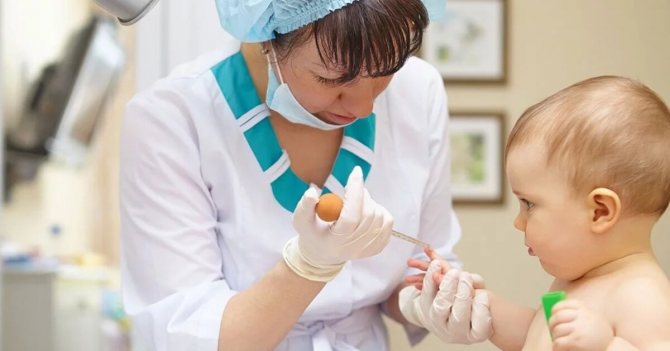
Blood for analysis
Most often, the doctor only needs to interview the parents and examine the baby to make an accurate diagnosis.
Rash due to infectious diseases
Childhood illnesses are often accompanied by rashes. The appearance of a rash on the head, then on the stomach, and then on the limbs may indicate chickenpox. The rash looks like small blisters with cloudy fluid inside. After they open, an itchy crust forms.
With scarlet fever, the rash is a rich red color, localized on the neck and upper body. They leave behind flaky spots.
With measles, the rash appears on the face and then spreads throughout the body. The spots are bright red and seem to protrude above the skin.
IMPORTANT TO KNOW: Sugaring bikini: how to do it yourself at home, step-by-step instructions
If small red spots are added to the signs of the inflammatory process, spreading from the face throughout the body, then rubella infection is likely.
In any of the above cases, you must immediately consult a doctor and, after diagnosing the disease, begin treatment.
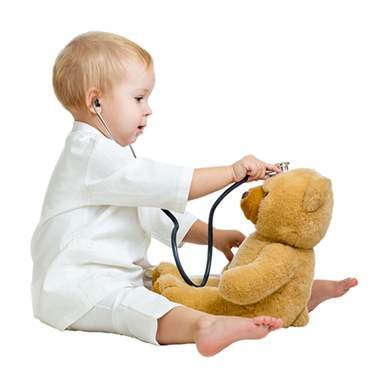
Dr. Komarovsky about rashes in babies
There is a special type of rash characteristic of children from 6 months to 2 years. First, the child develops an elevated body temperature, the range of which varies from 37.5˚C to 38.5˚C. It persists for 3-4 days and is not accompanied by other symptoms characteristic of ARVI: there is no cough, runny nose or weakness. On the day when the temperature returns to normal without any treatment, a small red rash appears on the back, shoulders and neck. It doesn't itch and doesn't bother you. The cause of this condition is a type of herpes - sudden exanthema.
Evgeniy Komarovsky, sharing his experience, reports that, despite the obviousness of the detection, this diagnosis is rarely made to children. The reason for the phenomenon lies in the parents - the average mother cannot simply look at a child with a fever and not use antipyretic medications. Therefore, according to the mother, the following picture emerges: the baby’s temperature rose, from which the mother gave antipyretic syrup, after which a rash appeared on the body. There is an allergic reaction to the components of the drug. It is this entry that is most often found in children's medical records.
Dangerous consequences
Advanced cases of skin inflammation in infants can lead to scars that will last a lifetime. A rash similar to urticaria, significantly worsening after each meal and accompanied by itching, may indicate fermentopathy. This phenomenon occurs when the liver and pancreas do not produce enough enzymes, causing any food to cause rashes because it cannot be digested. With this type of rash, it is necessary to examine the digestive organs in detail in order to begin restoring the functions of important internal organs as early as possible.
The most dangerous rash is the one that does not look like pimples, but like small hemorrhages. If you press on such redness with your finger, it will not lighten. This is a sign of meningococcal infection, which is very dangerous due to its consequences for the brain and life of the child. As soon as such a rash appears, you need to rush to the hospital, the hours are counting.
Preventive measures
It is easier to prevent any disease than to treat it. Therefore, preventive measures can be considered:
- keeping the children's room in order;
- daily hygiene procedures;
- use of clothing and bedding for the child only from natural and breathable materials;
- use only high-quality diapers;
- treating the child’s skin, especially the bottom, after each bath with a cream without dyes or fragrances;
- careful approach to complementary feeding, following the recommendations of the World Health Organization.

Healthy baby
Attentive attitude to the child will allow you to detect the causes of changes in the skin in time. For example, a rash localized only on a child’s ears most likely indicates that the baby is teething - children often grab their ears when they experience discomfort due to pain in the jaw. Dangerous skin problems are extremely rare, but redness due to a child sweating or eating an adult product is not at all uncommon. The awareness of parents can eliminate most rashes.


